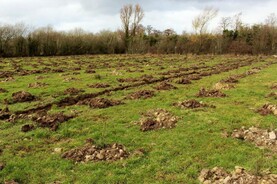Farmers who have land vested under the A5 road project will not receive preferential treatment with either farm payment claims or planning applications for new sheds.
At Stormont on Tuesday, Anna Campbell from DAERA pointed out that land vested for the road upgrade is not eligible for farm payments in the 2025 scheme year.
“The onus is very much on farm businesses to ensure that their land is correct. The letters and communication have made that very clear the whole way through.
“We will apply the rules of the scheme in the way that they should be and in line with what has been communicated to farm businesses,” she said.
Similarly, Keith Finegan from DAERA said A5 landowners that apply for planning permission for new livestock housing will not be given more leniency with rules around ammonia emissions.
“We certainly can’t direct the planning officials to take a different approach to certain developments. Our conservation advice has to be based on science and the law,” he said.
Finegan said his understanding was that the only farm building that needs to be demolished for the new A5 road is a broiler shed near Ballygawley.
However, in his evidence session, Omagh farmer John Robinson said more planning applications for new sheds will be inevitable after the road splits farms into different blocks.
“There will be dozens and dozens of people looking to put up new sheds. There would need to be some sort of leeway,” he said.
Robinson was critical of DAERA’s reluctance to allow flexibility with claiming areas of vested land under the 2025 single application.
MLAs were told the process of amending claims was difficult as information about vested land was not given to landowners on DAERA maps with individual field numbers.
“There are going to be major mistakes made, even with just half an acre or a quarter of an acre here or there,” Robinson said.
Compensation
The cereal grower also took issue with the levels of compensation that are being offered to A5 landowners and pointed to land that was recently sold in Newtownstewart for £30,000 per acre.
“They’re talking about £18,000 an acre. That’s £10,000 an acre short. We grow crops on good, dry, free draining soil. I’ll be looking to replace my land with the same type or better,” he said.
However, Robinson said A5 landowners will likely have limited opportunity to buy new land and so there will be big capital gains tax bills if compensation money is not re-invested.
“There’s 3,000 acres of land going to go from Ballygawley to Derry. There won’t be 300 acres for sale in the next 10 years along that corridor,” he said.
Most new sheds lead to higher emissions
There has only been one planning application for a farm shed in NI so far this year which would lead to a lower environmental impact, according to Keith Finegan from DAERA.
“Out of the 104 agricultural planning applications that we have been consulted on, only one had a reduction in pollution. We supported that application as we had no concerns,” he said. Speaking at Stormont, Finegan said that current planning rules on replacement farm sheds are based on the environmental impact of the proposed building, not the difference between the old and new shed.
“If someone is emitting a significant amount of pollution and they [propose to] reduce the pollution by a certain amount, there may still be an environmental impact,” he said.






 This is a subscriber-only article
This is a subscriber-only article










SHARING OPTIONS: